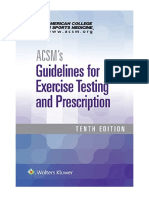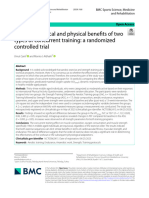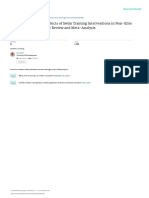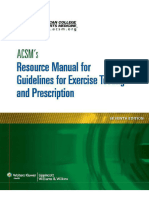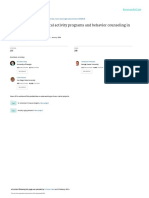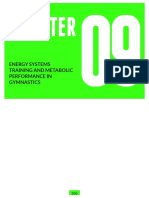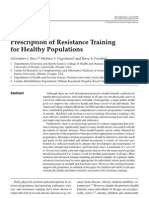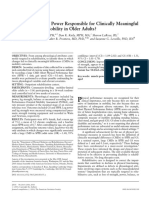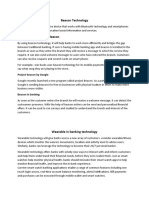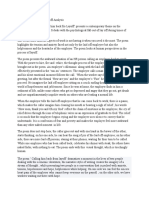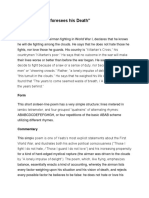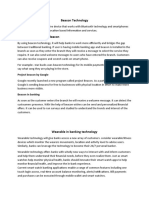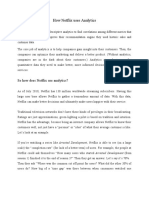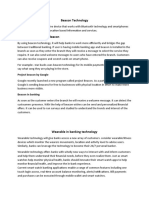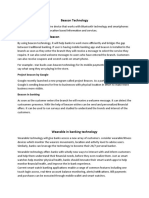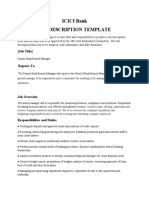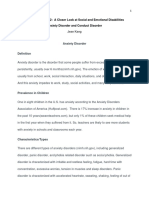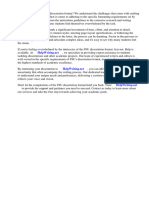Professional Documents
Culture Documents
ACSM Guidelines Download
ACSM Guidelines Download
Uploaded by
GOLDEN FIZZIK GYMCopyright
Available Formats
Share this document
Did you find this document useful?
Is this content inappropriate?
Report this DocumentCopyright:
Available Formats
ACSM Guidelines Download
ACSM Guidelines Download
Uploaded by
GOLDEN FIZZIK GYMCopyright:
Available Formats
ACSM’s Guidelines for
Exercise Testing and
Prescription, 11th edition
This download is part of the
additional materials included only on
the book’s companion website,
available with purchase of the book.
Visit Read & Research tab on the
ACSM website to find out more about
this and other ACSM publications:
https://www.acsm.org/read-
research/books.
Table of Contents
1 Benefits and Risks Associated with Physical Activity
2 Preexercise Evaluation
3 Health-Related Physical Fitness Testing and Interpretation
4 Clinical Exercise Testing and Interpretation
5 General Principles of Exercise Prescription
6 Exercise Prescription for Healthy Populations with Special
Consideration
7 Environmental Considerations for Exercise Prescription
8 Exercise Prescription for Individuals with Cardiovascular and
Pulmonary Diseases
9 Exercise Prescription for Individuals with Metabolic Disease and
Cardiovascular Disease Risk Factors
10 Exercise Testing and Prescription for Populations with Other
Chronic Diseases and Health Conditions
11 Brain Health and Brain-Related Disorders
12 Behavioral Theories and Strategies for Promoting Exercise
Appendix A Common Medications
Appendix B Electrocardiogram Interpretation
Appendix C American College of Sports Medicine Certifications
Appendix D Metabolic Calculations and Methods for Prescribing
Exercise Intensity
For more information about the American College of Sports
Medicine, visit www.acsm.org, www.acsm.org/facebook, and
www.twitter.com/acsmnews.
ACSM’S
Guidelines for
Exercise Testing
and Prescription
Eleventh Edition
00i-xxxiv_ACSM-GETP11e_FM_final.indd i 10/19/20 11:17 PM
SENIOR EDITOR ASSOCIATE EDITORS
Gary Liguori, PhD, FACSM, Yuri Feito, PhD, FACSM,
ACSM-CEP ACSM-CEP
Dean, College of Health Sciences Associate Professor of Exercise Science
Professor, Department of Kinesiology Kennesaw State University
University of Rhode Island Kennesaw, Georgia
Kingston, Rhode Island
Charles Fountaine, PhD,
FACSM
Professor, Department of Applied
Human Sciences
University of Minnesota Duluth
Duluth, Minnesota
Brad A. Roy, PhD, FACSM,
ACSM-CEP
Executive Director
Kalispell Regional Medical Center
The Summit Medical Fitness Center
Kalispell, Montana
00i-xxxiv_ACSM-GETP11e_FM_final.indd ii 10/19/20 11:17 PM
CHAPTER
1
Benefits and
Risks Associated with
Physical Activity
INTRODUCTION
This chapter summarizes information regarding the benefits and risks of physi-
cal activity (PA) and/or exercise. Additional information related to the benefits of
PA and exercise specific to a disease, disability, or health condition are explained
within the respective chapters of this edition of the guidelines. PA continues to
take on an increasingly important role in the prevention and treatment of mul-
tiple chronic diseases, health conditions, and their associated risk factors. Thus,
this chapter focuses on the public health perspective that forms the basis for the
current PA recommendations (1–6). Additionally, this chapter concludes with
recommendations for reducing the incidence and severity of exercise-related
complications for primary and secondary prevention programs.
PHYSICAL ACTIVITY AND FITNESS TERMINOLOGY
PA and exercise are often used interchangeably; however, these terms are not syn-
onymous. PA is defined as any bodily movement produced by the contraction of
skeletal muscles that results in an increase in caloric requirements over resting
energy expenditure (7). Exercise, on the other hand, is a type of PA consisting
of planned, structured, and repetitive bodily movement done to improve and/or
maintain one or more components of physical fitness (7). Physical fitness, although
defined in several ways, has generally been described as a set of attributes or char-
acteristics individuals have or achieve that relate to their ability to perform PA and
activities of daily living (7). These attributes or characteristics are commonly sep-
arated into health- and skill-related components of physical fitness. Nonetheless,
recent evidence suggests these components of physical fitness may not be mutu-
ally exclusive, as several skill-related components can be important for achieving
health goals and therefore should be incorporated when designing exercise pre-
scription programs with different populations (e.g., power and balance activities
with older adults) (Box 1.1).
1
Copyright © 2021 Wolters Kluwer. Unauthorized reproduction of the article is prohibited.
ACSM-GETP11e_CH01.indd 1 8/27/20 10:31 PM
2 ACSM’s Guidelines for Exercise Testing • www.acsm.org
Health- and Skill-Related Components of
Box 1.1
Physical Fitness
Health-Related Physical Fitness Components
l Cardiorespiratory endurance: the ability of the circulatory and respiratory
system to supply oxygen during sustained physical activity
l Body composition: the relative amounts of muscle, fat, bone, and other
vital parts of the body
l Muscular strength: the ability of muscle to exert force
l Muscular endurance: the ability of muscle to continue to perform without
fatigue
l Flexibility: the range of motion available at a joint
Skill-Related Physical Fitness Components
l Agility: the ability to change the position of the body in space with speed
and accuracy
l Coordination: the ability to use the senses, such as sight and hearing,
together with body parts in performing tasks smoothly and accurately
l Balance: the maintenance of equilibrium while stationary or moving
l Power: the ability or rate at which one can perform work
l Reaction time: the time elapsed between stimulation and the beginning
of the reaction to it
l Speed: the ability to perform a movement within a short period of time
Adapted from (7).
In addition to defining PA, it is important to clearly define the wide range of
intensities associated with PA (see Table 5.2) and with different methods for es-
timating intensities, which includes percentage of oxygen uptake reserve (V̇O2R),
heart rate reserve (HRR), volume of oxygen consumed per minute (V̇O2), heart
rate (HR), or metabolic equivalents (METs; see Box 5.2 and Appendix D). Several
chapters throughout the guidelines provide the methodology and guidance for
selecting a suitable estimation method based on individual circumstances.
METs are a useful, convenient, and standardized method for quantifying the
absolute intensity of various behaviors and activities. Among adults, light inten-
sity PA is defined as 1.6–2.9 METs, moderate as 3.0–5.9 METs, and vigorous as
6.0 METs (6). Table 1.1 gives specific examples of MET values for activities in
each of the described intensity ranges. A comprehensive catalog of absolute inten-
sity values for various behaviors and activities can be found in the Compendium
of Physical Activities (8).
Because of age-related declines in maximal aerobic capacity (4,11), when older
and younger individuals work at the same MET level, the relative exercise inten-
sity (e.g., %V̇O2max) will usually be different (see Chapter 5). In other words, the
older individual will be working at a greater relative percentage of maximal oxy-
gen consumption (V̇O2max) than their younger counterparts. Nonetheless, physi-
cally active older adults may have aerobic capacities comparable to or greater than
those of physically inactive younger adults. This relationship will be similar when
Copyright © 2021 Wolters Kluwer. Unauthorized reproduction of the article is prohibited.
ACSM-GETP11e_CH01.indd 2 8/27/20 10:31 PM
Chapter 1 Benefits and Risks Associated with Physical Activity 3
TABLE 1.1 • Metabolic Equivalents (METs) Values of Common Physical
Activities Classified as Light, Moderate, or Vigorous Intensity
Light Moderate Vigorous
(1.6–2.9 METs) (3.0–5.9 METs) (6.0 METs)
Walking Walking Walking, jogging,
Walking slowly around Walking 3.0 mi h21 5 3.0a and running
home, store, or Walking at very brisk pace Walking at very, very brisk
office 5 2.0a (4 mi h21) 5 5.0a pace (4.5 mi h21) 5 6.3a
Walking/hiking at moderate
Household and occupation Household and occupation
pace and grade with no or
Standing performing light Cleaning, heavy —
light pack (,10 lb) 5 7.0
work, such as making bed, washing windows, car,
Hiking at steep grades and
washing dishes, ironing, clean garage 5 3.0
pack 10–42 lb 5 7.5–9.0
preparing food, or store Sweeping floors or
Jogging at 5 mi h21 5 8.0a
clerk 5 2.0–2.5 carpet, vacuuming,
Jogging at 6 mi h21 5 10.0a
mopping 5 3.0–3.5
Leisure time and sports Running at 7 mi h21 5 11.5a
Carpentry — general 5 3.6
Billiards 5 2.5
Carrying and stacking Household and occupation
Boating — power 5 2.5
wood 5 5.5 Shoveling sand, coal,
Croquet 5 2.5
Mowing lawn — walk power etc. 5 7.0
Darts 5 2.5
mower 5 5.5 Carrying heavy loads,
Fishing — sitting 5 2.5
such as bricks 5 7.5
Playing most musical Leisure time and sports
Heavy farming, such as
instruments 5 2.0–2.5 Badminton —
bailing hay 5 8.0
recreational 5 4.5
Shoveling, digging
Basketball — shooting
ditches 5 8.5
around 5 4.5
Dancing — ballroom Leisure time and sports
slow 5 3.0; ballroom Bicycling on flat — light
fast 5 4.5 effort (10–12 mi h21) 5 6.0
Fishing from riverbank Basketball game 5 8.0
and walking 5 4.0 Bicycling on flat — moderate
Golf — walking, pulling effort (12–14 mi 5 h21) 5 8.0;
clubs 5 4.3 fast (14–16 mi h21) 5 10.0
Sailing boat, wind Skiing cross-country —
surfing 5 3.0 slow (2.5 mi h21) 5 7.0;
Table tennis 5 4.0 fast (5.0–7.9 mi h21) 5 9.0
Tennis doubles 5 5.0 Soccer — casual 5 7.0;
Volleyball — competitive 5 10.0
noncompetitive 5 3.0–4.0 Swimming leisurely 5 6.0b;
swimming — moderate/
hard 5 8.0–11.0b
Tennis singles 5 8.0
Volleyball — competitive at
gym or beach 5 8.0
a
On flat, hard surface.
b
MET values can vary substantially from individual to individual during swimming
as a result of different strokes and skill levels.
Adapted from (8–10).
Copyright © 2021 Wolters Kluwer. Unauthorized reproduction of the article is prohibited.
ACSM-GETP11e_CH01.indd 3 8/27/20 10:31 PM
4 ACSM’s Guidelines for Exercise Testing • www.acsm.org
comparing individuals with different fitness levels, where those with lower V̇O2max
will work at a higher percentage of their maximal ability compared to their more
fit counterparts at the same absolute MET value.
PUBLIC HEALTH PERSPECTIVE FOR CURRENT
RECOMMENDATIONS
More than 20 yr ago, the American College of Sports Medicine (ACSM), in con-
junction with the Centers for Disease Control and Prevention (CDC) (12), the U.S.
Surgeon General (13), and the National Institutes of Health (14), issued landmark
publications on PA and health. An important goal of these reports was to clarify
for exercise professionals and the public the amount and intensity of PA needed to
improve health, lower susceptibility to disease (morbidity), and decrease prema-
ture mortality (12–14). In addition, these reports documented the dose-response
relationship between PA and health (i.e., some activity is better than none, and
more activity, up to a point, is better than less).
In 1995, the CDC and ACSM recommended that “every U.S. adult should accu-
mulate 30 minutes or more of moderate physical activity on most, preferably all, days
of the week” (12). This recommendation was quickly followed in 1996 by the Physi-
cal Activity and Health: A Report of the Surgeon General, a landmark report detailing
the myriad health benefits associated with regular PA (13). Collectively, the intent of
these statements was to increase public awareness of the health-related benefits of
moderate intensity PA. As a result of an increasing awareness of the adverse health
effects of physical inactivity and because of some confusion and misinterpretation
of the original PA recommendations, the ACSM and American Heart Association
(AHA) issued updated recommendations for PA and health in 2007 (Box 1.2) (3).
The ACSM–AHA Primary Physical Activity
Box 1.2
Recommendations (3)
l All healthy adults aged 18–65 yr should participate in moderate intensity
aerobic PA for a minimum of 30 min on 5 d wk1 or vigorous intensity
aerobic activity for a minimum of 20 min on 3 d wk1.
l Combinations of moderate and vigorous intensity exercise can be
performed to meet this recommendation.
l Moderate intensity aerobic activity can be accumulated to total the
30 min minimum by performing bouts each lasting 10 min.
l Every adult should perform activities that maintain or increase muscular
strength and endurance for a minimum of 2 d wk1.
l Because of the dose-response relationship between PA and health,
individuals who wish to further improve their fitness, reduce their risk for
chronic diseases and disabilities, and/or prevent unhealthy weight gain
may benefit by exceeding the minimum recommended amounts of PA.
ACSM, American College of Sports Medicine; AHA, American Heart Association.
Copyright © 2021 Wolters Kluwer. Unauthorized reproduction of the article is prohibited.
ACSM-GETP11e_CH01.indd 4 8/27/20 10:31 PM
CHAPTER
11
Brain Health and
Brain-Related Disorders
INTRODUCTION
Brain health can be broadly defined as the optimal or maximal functioning
of behavioral and biological measures of the brain and the subjective expe-
riences arising from brain function (e.g., mood). The 2018 Physical Activity
Guidelines Scientific Report (1) concluded that there is unequivocal evidence
that exercise influences brain health and that individuals with conditions that
affect brain health (e.g., major depression) could greatly benefit from engaging
in exercise.
This chapter contains the exercise testing and exercise prescription (Ex Rx)
guidelines and recommendations for individuals with health conditions related to
the brain. As with the other chapters, the Ex Rx guidelines and recommendations
are presented using the Frequency, Intensity, Time, and Type (FITT) principle of
Ex Rx based on the available evidence from professional society position papers
and scientific literature. For some brain health conditions, there is insufficient
information regarding appropriate volume and progression of exercise training.
In these instances, guidelines and recommendations provided in other chapters
of the ACSM Guidelines should be adapted with good clinical judgment for the
condition being targeted. In many instances, exercise training can be performed
without a prior clinical exercise test. However, if an exercise test is to be performed,
this chapter presents specific recommendations for individuals with various brain
health conditions.
One area of brain health that is of high public interest is concussion. However, at the time this
11th edition of the ACSM Guidelines was published, there was limited evidence on the role of
exercise or physical activity in the mitigation of, or recovery from, concussion. Future editions
of the ACSM Guidelines and other ACSM publications will contain concussion information as it
relates to exercise and physical activity, as the supporting evidence emerges.
378
Copyright © 2021 Wolters Kluwer. Unauthorized reproduction of the article is prohibited.
ACSM-GETP11e_CH11.indd 378 8/27/20 10:35 PM
Chapter 11 Brain Health and Brain-Related Disorders 379
ATTENTION-DEFICIT/HYPERACTIVITY DISORDER
Attention-deficit/hyperactivity disorder (ADHD) is a common neurodevelopmen-
tal disorder characterized by inattention, hyperactivity-impulsivity, or both (2).
The prevalence of ADHD worldwide is approximately 5% in children-adolescents
and an average around 2.5%–3.4% for adults (3). However, estimates in children-
adolescents vary across sex, being markedly more prevalent in boys than in girls
with a ratio of 2–3:1 (4,5). Existing data support that ADHD prevalence has not
increased over the last three decades (4). Despite the popular belief that ADHD
is mainly a pediatric disorder, meta-analyses of follow-up studies have shown that
around 65% of ADHD children will continue having ADHD when adults (6).
Problems related to ADHD include psychiatric comorbidities (e.g., major depres-
sion, anxiety, bipolar disorder), health problems (e.g., obesity, hypertension), psy-
chological dysfunction, academic and occupational failure, social disability, and
risky behaviors (e.g., lying, stealing, and substance abuse) (2).
ADHD is a complex disorder, and its etiology is not yet completely under-
stood. Although there is evidence that environmental factors play an important
role, ADHD has a strong genetic component, with heritability estimates averag-
ing approximately 75% (6–8). Both pharmacological and nonpharmacological
treatments are used to treat ADHD. Although nonstimulants (e.g., selective nor-
adrenaline reuptake inhibitor atomoxetine and long-acting formulations of two
2-adrenergic agonist drugs clonidine and guanfacine) are sometimes used based
on contraindications or personal preferences, stimulants (such as amphetamine
or methylphenidate) are mostly used to treat ADHD in individuals of all ages (2).
Additionally, nonpharmacological treatments, such as dietary, neurocognitive,
and behavioral therapies, are also used as an alternative or complement to phar-
macological treatments.
According to the 2018 Physical Activity Guidelines Advisory Committee, reg-
ular physical activity (PA) improves multiple dimensions of cognition, including
two which are of utmost importance for individuals with ADHD: attention and
inhibition (1). Inattentiveness is one of the core symptoms of ADHD, and the most
updated evidence from the Physical Activity Guidelines Advisory Committee re-
port strongly supports the use of PA to improve attention (9). Impulsivity is another
core symptom of ADHD. Existing evidence supports a link between engagement
in PA and improvements in cognitive inhibition (10,11). Cognitive inhibition is a
major component of executive function dealing with the ability of people to inhibit
responses in order to better respond to a specific stimulus. In this context, exercise
has been shown to improve inhibition in the general population (12) and children
suffering from ADHD (10). Other cognitive functions, such as a better ability to
plan and organize daily life activities, considered to be part of executive function,
are also positively related to exercise in the general population and can provide
additional benefits to those with ADHD (1,13,14). Moreover, sleep duration and
quality are often impaired in those with ADHD (15; see reference [13] for a re-
view). The Physical Activity Guidelines Advisory Committee report supports that
physically active people have a better sleep quality in terms of the time in bed to
Copyright © 2021 Wolters Kluwer. Unauthorized reproduction of the article is prohibited.
ACSM-GETP11e_CH11.indd 379 8/27/20 10:35 PM
380 ACSM’s Guidelines for Exercise Testing • www.acsm.org
sleep onset, number and duration of times that a person wakes up at night after
having fallen asleep, and sleep efficiency, among others (1). This would, therefore,
be another mechanism by which exercise can improve ADHD symptomatology.
Major comorbidities in ADHD include obesity (see Chapter 9), hypertension
(see Chapter 9), and depression/anxiety (as discussed in this chapter) (2,3,16,17),
and exercise can play a key role in mitigating each of these conditions (1).
Exercise Testing
Given the higher prevalence of ADHD in childhood/adolescence than in adult-
hood, the considerations about exercise testing for individuals with ADHD
will be mainly those referred to children and adolescents. In most of cases, in-
dividuals with ADHD can start a moderate intensity exercise program without
previous medical screening, considering exercise testing for clinical purposes
is not necessary unless there is any other health concern (18–20). However, ex-
ercise testing both in pediatric and adult populations is always informative as a
health indicator and for monitoring improvements in fitness as a consequence of
exercise (21). When doing so, the recommendations for exercise testing in the
general population (see Chapters 3 and 4) will apply to ADHD (22). In children
and adolescents, the most updated and evidence-based fitness test battery is the
European Union-funded ALPHA battery (23–26), also supported by the Institute
of Medicine in the United States (27,28). The tests selected for being the most
valid, reliable, and related to future health are (a) the 20-m shuttle run test to assess
cardiorespiratory fitness (CRF); (b) the handgrip strength and (c) standing broad
jump to assess musculoskeletal fitness; and (d) body mass index (BMI), (e) skinfold
thickness, and (5) waist circumference to assess body composition (26). Interna-
tional reference values for correct sex- and age-specific interpretation of fitness
assessment are available elsewhere (29–32). Most of these tests are also included
in the FITNESSGRAM battery. If ADHD is presented with comorbidities, exercise
professionals should review relevant exercise testing options as listed elsewhere in
the ACSM Guidelines.
Exercise Prescription
Because ADHD is most commonly diagnosed early in life, the Ex Rx principles
for healthy children and adolescents apply in ADHD (see Chapter 6). Given that
ADHD continues into adulthood for nearly two-thirds of children, adult Ex Rx
principles also apply (see Chapter 5).
Exercise Considerations
l Attention should be paid to potentially coexisting comorbidities, such as over-
weight/obesity, hypertension, and depression/anxiety.
l Emerging evidence suggests that low physical fitness is common in ADHD
(18–20,33). Care should be taken to start slow and to set realistic goals for fitness
in this population.
Copyright © 2021 Wolters Kluwer. Unauthorized reproduction of the article is prohibited.
ACSM-GETP11e_CH11.indd 380 8/27/20 10:35 PM
Thank you for downloading
this excerpt! Visit Read &
Research tab on the ACSM
website to find out more
about this and other ACSM
publications:
https://www.acsm.org/read-
research/books.
The American College of Sports Medicine (ACSM)
founded in 1954 is the largest sports medicine and
exercise science organization in the world. With
more than 50,000 members and certified
professionals worldwide, ACSM is dedicated to
improving health through science, education, and
medicine. ACSM members work in a wide range of
medical specialties, allied health professions, and
scientific disciplines. Members are committed to the
diagnosis, treatment, and prevention of sport-
related injuries and the advancement of the science
of exercise. The ACSM promotes and integrates
scientific research, education, and practical
applications of sports medicine and exercise science
to maintain and enhance physical performance,
fitness, health, and quality of life. For more
information, visit www.acsm.org,
www.acsm.org/facebook, and
www.twitter.com/acsmnews.
You might also like
- Acsms Introduction To Exercise Science 3rd Edition Ebook PDFDocument61 pagesAcsms Introduction To Exercise Science 3rd Edition Ebook PDFjames.keeter43298% (51)
- Organizing Solutions For People With ADHD, 2nd Edition-Revised and UpdatedDocument221 pagesOrganizing Solutions For People With ADHD, 2nd Edition-Revised and Updateddoppler_96% (48)
- Magee 6th Edition - OPA - Orthopedic Physical AssessmentDocument1 pageMagee 6th Edition - OPA - Orthopedic Physical AssessmentRonny Araya Abarca50% (10)
- Transformational Piano Teaching Mentoring Students From All Walks of Life Derek Kealii Polischuk All ChapterDocument67 pagesTransformational Piano Teaching Mentoring Students From All Walks of Life Derek Kealii Polischuk All Chapterjohnna.martin254100% (7)
- ADHD and AUTISM Nutrition BookDocument376 pagesADHD and AUTISM Nutrition Bookalinecanavez100% (1)
- ACSM's Guidelines For Exercise Testing and Prescription - American College of Sports MedicineDocument5 pagesACSM's Guidelines For Exercise Testing and Prescription - American College of Sports Medicinexyfafyju0% (4)
- Rehabilitation of The Postpartum Runner: A 4-Phase ApproachDocument14 pagesRehabilitation of The Postpartum Runner: A 4-Phase ApproachRichard CortezNoch keine Bewertungen
- Coughlin Psyc Exam Results OcrDocument10 pagesCoughlin Psyc Exam Results OcrDoTheMacaRenoNoch keine Bewertungen
- ACSMs Exercise Testing Prescription PDFDocument6 pagesACSMs Exercise Testing Prescription PDFHARIZNoch keine Bewertungen
- ACSMs Exercise Testing Prescription PDFDocument6 pagesACSMs Exercise Testing Prescription PDFHARIZNoch keine Bewertungen
- Acsm Certified Clinical Exercise Physiologist Exam Content Outline PDFDocument18 pagesAcsm Certified Clinical Exercise Physiologist Exam Content Outline PDFFabiano Henrique0% (1)
- (15435474 - Journal of Physical Activity and Health) Framework For Physical Activity As A Complex and Multidimensional BehaviorDocument8 pages(15435474 - Journal of Physical Activity and Health) Framework For Physical Activity As A Complex and Multidimensional BehaviorarcadetorNoch keine Bewertungen
- Framework IntradialisisDocument8 pagesFramework IntradialisisNovara Qus'nul LuvfiantiNoch keine Bewertungen
- Kinesiology The Mechanics and Pathomechanics of Human Movement 3Rd Edition PDF Full Chapter PDFDocument41 pagesKinesiology The Mechanics and Pathomechanics of Human Movement 3Rd Edition PDF Full Chapter PDFmatezhyba100% (5)
- Long QuizDocument6 pagesLong QuizMae EsmadeNoch keine Bewertungen
- 2015 Article 155Document16 pages2015 Article 155Tito AlhoNoch keine Bewertungen
- DownloadDocument9 pagesDownloadcesar8319Noch keine Bewertungen
- Kinesiology The Mechanics and Pathomechanics of Human Movement 3rd Edition Ebook PDFDocument62 pagesKinesiology The Mechanics and Pathomechanics of Human Movement 3rd Edition Ebook PDFbruce.glinski869100% (52)
- Resistance Training Load Effects On Muscle Hypertrophy and Strength Gain: Systematic Review and Network Meta-AnalysisDocument11 pagesResistance Training Load Effects On Muscle Hypertrophy and Strength Gain: Systematic Review and Network Meta-AnalysisEduardo Paulista FrizzoNoch keine Bewertungen
- PAPER 2 SEMANA 1 2017-The Limits of Exercise Physiology - From Performance To HealthDocument12 pagesPAPER 2 SEMANA 1 2017-The Limits of Exercise Physiology - From Performance To Healthsebakinesico-1Noch keine Bewertungen
- The Physiological and Physical Benefits of Two Types of Concurrent Training: A Randomized Controlled TrialDocument10 pagesThe Physiological and Physical Benefits of Two Types of Concurrent Training: A Randomized Controlled TrialChloe BujuoirNoch keine Bewertungen
- 1 s2.0 S155041311630225X MainDocument14 pages1 s2.0 S155041311630225X Mainadi pranotoNoch keine Bewertungen
- JAP Timmons Variation ReviewDocument9 pagesJAP Timmons Variation ReviewJorge Pérez CórdobaNoch keine Bewertungen
- Effects of Physical Exercise in Older Adults With Reduced Physical Capacity Meta-Analysis of Resistance Exercise and MultimodalDocument12 pagesEffects of Physical Exercise in Older Adults With Reduced Physical Capacity Meta-Analysis of Resistance Exercise and MultimodalabcsouzaNoch keine Bewertungen
- Chronic Physiological Effects of Swim Training Interventions in Non-Elite Swimmers: A Systematic Review and Meta-AnalysisDocument24 pagesChronic Physiological Effects of Swim Training Interventions in Non-Elite Swimmers: A Systematic Review and Meta-AnalysisHayden KerekesNoch keine Bewertungen
- Activity (Measurement) Budget Wisely Commentaries On Viewpoint: Expending Our PhysicalDocument7 pagesActivity (Measurement) Budget Wisely Commentaries On Viewpoint: Expending Our PhysicalYeboto PiratadelcaribeNoch keine Bewertungen
- 2019 Article AbstractsFromThe5thInternation PDFDocument41 pages2019 Article AbstractsFromThe5thInternation PDFStephano NgangiNoch keine Bewertungen
- Introduction Exercise PhysiologyDocument20 pagesIntroduction Exercise Physiologymuhammad umar100% (1)
- Impact of Resistance Circuit Training On Neuromuscular, Cardiorespiratory and Body Composition Adaptations in The ElderlyDocument8 pagesImpact of Resistance Circuit Training On Neuromuscular, Cardiorespiratory and Body Composition Adaptations in The ElderlyBryan HuaritaNoch keine Bewertungen
- Efects of Adding Aerobic Physical ActivityDocument18 pagesEfects of Adding Aerobic Physical Activitydavid fernandezNoch keine Bewertungen
- BIOESTADÍSTICADocument11 pagesBIOESTADÍSTICAShunaxhi CruzNoch keine Bewertungen
- Versic 2021Document16 pagesVersic 2021Willian da costaNoch keine Bewertungen
- The Effectiveness of Physiotherapy Exercises in Subacromial Impingement Syndrome: A Systematic Review and Meta-AnalysisDocument21 pagesThe Effectiveness of Physiotherapy Exercises in Subacromial Impingement Syndrome: A Systematic Review and Meta-Analysisilham Maulana ArifNoch keine Bewertungen
- Heale - Et .Al .Fall .2023.pdf IJREPDocument19 pagesHeale - Et .Al .Fall .2023.pdf IJREPJoan Vinata WinonaNoch keine Bewertungen
- Resistance_to_Exercise_Induced_Weight_Loss_.22Document10 pagesResistance_to_Exercise_Induced_Weight_Loss_.22Tennis workbookNoch keine Bewertungen
- The Effectiveness of Physiotherapy Exercises in Subacromial Impingement Syndrome: A Systematic Review and Meta-AnalysisDocument20 pagesThe Effectiveness of Physiotherapy Exercises in Subacromial Impingement Syndrome: A Systematic Review and Meta-AnalysisBruno FellipeNoch keine Bewertungen
- 2.0 Introduction To Exercise Physiology SPS135Document53 pages2.0 Introduction To Exercise Physiology SPS135MUHAMMAD ARIF BIN MOHAMAD NOOR AZMANNoch keine Bewertungen
- Effects of Different Exercise Interventions On Risk of Falls A Systematic ReviewDocument10 pagesEffects of Different Exercise Interventions On Risk of Falls A Systematic ReviewLeonardoValenzuelaNoch keine Bewertungen
- American College of Sports Medicine - ACSM's Resource Manual For Guidelines For Exercise Testing and PrescriptionDocument1,786 pagesAmerican College of Sports Medicine - ACSM's Resource Manual For Guidelines For Exercise Testing and PrescriptionHobo Jo100% (1)
- The Effects of Myofascial Release With Foam Rolling On Performance PDFDocument8 pagesThe Effects of Myofascial Release With Foam Rolling On Performance PDFhenriqueNoch keine Bewertungen
- BEAUDART 2019 Assessment of Muscle Function and Physical Performance in Daily Clinical PracticeDocument14 pagesBEAUDART 2019 Assessment of Muscle Function and Physical Performance in Daily Clinical PracticeCris AquinoNoch keine Bewertungen
- Research: Di EstDocument8 pagesResearch: Di EstLinton J. ThienNoch keine Bewertungen
- BestPracticesPA Behaviorcounseling OaDocument8 pagesBestPracticesPA Behaviorcounseling OaHarrison Moreno RoldánNoch keine Bewertungen
- Strength Training and Weight Loss: Treinamento de Força e EmagrecimentoDocument4 pagesStrength Training and Weight Loss: Treinamento de Força e EmagrecimentoDevasyaNoch keine Bewertungen
- Assessment of Physical Function in Geriatric OncologyDocument13 pagesAssessment of Physical Function in Geriatric OncologyLuis Aguirre TipismanaNoch keine Bewertungen
- 2012 If Exercise Is Medicine, Who Should Be The PrescriberDocument2 pages2012 If Exercise Is Medicine, Who Should Be The PrescriberCristiano MatosNoch keine Bewertungen
- Jurnal 1Document14 pagesJurnal 1williamadiwinataNoch keine Bewertungen
- Chapter 9 - Cardio and ESD PDFDocument28 pagesChapter 9 - Cardio and ESD PDFDDVNoch keine Bewertungen
- Prescription of Resistance Training For Healthy PopulationsDocument12 pagesPrescription of Resistance Training For Healthy PopulationsChristine LeeNoch keine Bewertungen
- Return To Running BolthouseDocument9 pagesReturn To Running BolthouseAriana IorgaNoch keine Bewertungen
- Beudart, C.Document17 pagesBeudart, C.Fillipe FelixNoch keine Bewertungen
- Artigo Levantamento e Sobrepeso - InglêsDocument6 pagesArtigo Levantamento e Sobrepeso - InglêsCíntia AnibalNoch keine Bewertungen
- Develop Med Child Neuro - 2016 - Verschuren - Exercise and Physical Activity Recommendations For People With Cerebral PalsyDocument11 pagesDevelop Med Child Neuro - 2016 - Verschuren - Exercise and Physical Activity Recommendations For People With Cerebral PalsyCláudia SilvaNoch keine Bewertungen
- Basic Exercise Physiology: Clinical and Laboratory PerspectivesFrom EverandBasic Exercise Physiology: Clinical and Laboratory PerspectivesNoch keine Bewertungen
- Physical Fitness of Physical Therapy StudentsDocument9 pagesPhysical Fitness of Physical Therapy StudentsDarkooCFNoch keine Bewertungen
- BMC NeurologyDocument9 pagesBMC NeurologyBASHArnNoch keine Bewertungen
- Bean 2010Document6 pagesBean 2010壮Noch keine Bewertungen
- JBMR 3905Document10 pagesJBMR 3905Panagiotes KoutelidakesNoch keine Bewertungen
- La Actividad Fisica y Los HuesosDocument10 pagesLa Actividad Fisica y Los HuesosyatibaduizaNoch keine Bewertungen
- Increased Rate of Force Development During Periodized Maximum Strength and Power Training Is Highly IndividualDocument10 pagesIncreased Rate of Force Development During Periodized Maximum Strength and Power Training Is Highly IndividualNazim DjedaaNoch keine Bewertungen
- Estudio Sobre La Restricción Del Flujo Sanguíneo en El EntrenamientoDocument11 pagesEstudio Sobre La Restricción Del Flujo Sanguíneo en El EntrenamientoEnrique Manuel CerettiNoch keine Bewertungen
- Overtraining Syndrome (Acsm)Document37 pagesOvertraining Syndrome (Acsm)Diego D ToledoNoch keine Bewertungen
- Movement Analysis FrameworkDocument8 pagesMovement Analysis FrameworkSM199021Noch keine Bewertungen
- Beacon Technology: Project Beacon by GoogleDocument2 pagesBeacon Technology: Project Beacon by GoogleGOLDEN FIZZIK GYMNoch keine Bewertungen
- Recent HR Strategies According To 2021Document2 pagesRecent HR Strategies According To 2021GOLDEN FIZZIK GYMNoch keine Bewertungen
- Calling Him Back From Layoff AnalysisDocument1 pageCalling Him Back From Layoff AnalysisGOLDEN FIZZIK GYMNoch keine Bewertungen
- Unit 1: Introduction To Kinesiology and Sports BiomechanicsDocument70 pagesUnit 1: Introduction To Kinesiology and Sports BiomechanicsGOLDEN FIZZIK GYM100% (1)
- Answers by Edith SitwellDocument2 pagesAnswers by Edith SitwellGOLDEN FIZZIK GYMNoch keine Bewertungen
- An Irish Airman Foresees His Death-3Document2 pagesAn Irish Airman Foresees His Death-3GOLDEN FIZZIK GYMNoch keine Bewertungen
- How Netflix Uses AnalyticsDocument3 pagesHow Netflix Uses AnalyticsGOLDEN FIZZIK GYMNoch keine Bewertungen
- LORE2012 Vol4No1 MinandKimDocument12 pagesLORE2012 Vol4No1 MinandKimGOLDEN FIZZIK GYMNoch keine Bewertungen
- Beacon Technology: Project Beacon by GoogleDocument2 pagesBeacon Technology: Project Beacon by GoogleGOLDEN FIZZIK GYMNoch keine Bewertungen
- How Netflix Uses AnalyticsDocument3 pagesHow Netflix Uses AnalyticsGOLDEN FIZZIK GYMNoch keine Bewertungen
- Beacon Technology: Project Beacon by GoogleDocument2 pagesBeacon Technology: Project Beacon by GoogleGOLDEN FIZZIK GYMNoch keine Bewertungen
- Calling Him Back From Layoff AnalysisDocument1 pageCalling Him Back From Layoff AnalysisGOLDEN FIZZIK GYMNoch keine Bewertungen
- Beacon Technology: Project Beacon by GoogleDocument2 pagesBeacon Technology: Project Beacon by GoogleGOLDEN FIZZIK GYMNoch keine Bewertungen
- Taj Mahal and ApjDocument13 pagesTaj Mahal and ApjGOLDEN FIZZIK GYMNoch keine Bewertungen
- A Painful Case-1Document7 pagesA Painful Case-1GOLDEN FIZZIK GYMNoch keine Bewertungen
- ICICI Bank DescriptionDocument2 pagesICICI Bank DescriptionGOLDEN FIZZIK GYMNoch keine Bewertungen
- Ohi 2Document6 pagesOhi 2api-242024640Noch keine Bewertungen
- McBurnett - Pfiffner ADHD Concepts Controversies New DirectionsDocument444 pagesMcBurnett - Pfiffner ADHD Concepts Controversies New DirectionsRute Almeida RomãoNoch keine Bewertungen
- Granny Storm Crowns ListDocument750 pagesGranny Storm Crowns ListMichael Grant WhiteNoch keine Bewertungen
- Psychiatric Nursing Bullets Lester R. L. LintaoDocument4 pagesPsychiatric Nursing Bullets Lester R. L. LintaoElizabella Henrietta TanaquilNoch keine Bewertungen
- Child and Adolescent DevelopmentDocument9 pagesChild and Adolescent DevelopmentFamela RamosNoch keine Bewertungen
- m3 Act3 Emotional DisabilitiesDocument7 pagesm3 Act3 Emotional Disabilitiesapi-516574894Noch keine Bewertungen
- Case PresentationDocument14 pagesCase PresentationTehmina IrfanNoch keine Bewertungen
- Created by Jose Garcia Luz Maria LavalleDocument29 pagesCreated by Jose Garcia Luz Maria LavalleLuz Maria LavalleNoch keine Bewertungen
- M A DDocument19 pagesM A DjoycesiosonNoch keine Bewertungen
- Home School Abbreviations 1Document19 pagesHome School Abbreviations 1LindseyNoch keine Bewertungen
- Adhd Add BluebookDocument52 pagesAdhd Add BluebookloganNoch keine Bewertungen
- Section 504 Power PointDocument25 pagesSection 504 Power PointCindy Miller- WalkerNoch keine Bewertungen
- Prenatal Developmental Origins of Behavior and Mental Health - The Influence of Maternal Stress in PregnancyDocument39 pagesPrenatal Developmental Origins of Behavior and Mental Health - The Influence of Maternal Stress in PregnancybleuegirlmxNoch keine Bewertungen
- Depression Supporting Students at School PDFDocument3 pagesDepression Supporting Students at School PDFMrié ChrsNoch keine Bewertungen
- Fsu Dissertation FormatDocument6 pagesFsu Dissertation FormatPaperWritingServiceCollegeUK100% (2)
- Pdev 111 Week 1 10Document26 pagesPdev 111 Week 1 10David83% (6)
- Cognitive-Behavioral Therapy For ADHD in Adolescents Clinical ConsiderationsDocument11 pagesCognitive-Behavioral Therapy For ADHD in Adolescents Clinical Considerationsdmsds100% (1)
- Garland Teresa Hands-On Activities For Children With Autism Sensory DisordersDocument396 pagesGarland Teresa Hands-On Activities For Children With Autism Sensory DisordersGriselda Leon100% (3)
- 7 Myths About ADHD - DebunkedDocument1 page7 Myths About ADHD - DebunkedDalila VicenteNoch keine Bewertungen
- How To Identify Adhd ChildrenDocument6 pagesHow To Identify Adhd ChildrenKUNNAMPALLIL GEJO JOHNNoch keine Bewertungen
- Adhd ManualDocument72 pagesAdhd ManualJuwita Pratiwi100% (1)
- Attention-Deficit Hyperactivity Disorder and Problems in Peer Relations: Predictions From Childhood To AdolescenceDocument8 pagesAttention-Deficit Hyperactivity Disorder and Problems in Peer Relations: Predictions From Childhood To AdolescenceJúlia JanoviczNoch keine Bewertungen
- Egger & Angold, 2006 Disorders - DiscussionDocument25 pagesEgger & Angold, 2006 Disorders - DiscussionAlkistis MarinakiNoch keine Bewertungen
- ADHD AssessmentDocument6 pagesADHD AssessmentIlma SikandarNoch keine Bewertungen
- Adhd and Alcohol UseDocument8 pagesAdhd and Alcohol UsedrrobbNoch keine Bewertungen
- Perdev Module ActivityDocument18 pagesPerdev Module ActivityMary Seal Cabrales-PejoNoch keine Bewertungen





